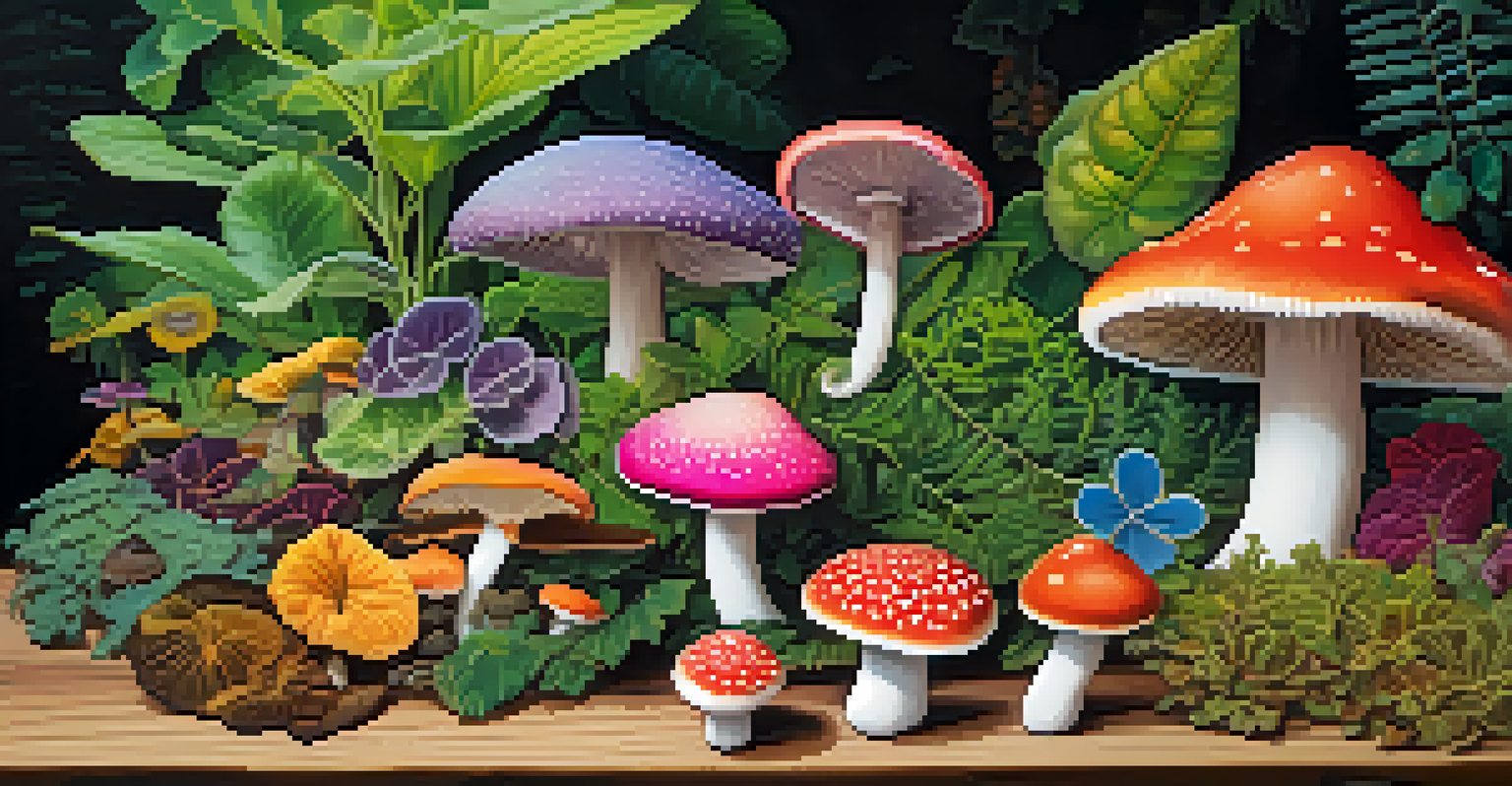Empathy Expansion: Entheogenic Experiences and Their Effects

Understanding Entheogens: More Than Just Psychedelics
Entheogens are substances that can induce altered states of consciousness, often used in spiritual or therapeutic contexts. Unlike recreational drugs, these compounds are typically used to foster profound personal insights and emotional connections. By exploring the nature of these experiences, we begin to appreciate their potential to expand empathy and understanding.
The purpose of entheogens is to induce a state of consciousness that facilitates profound personal insights and emotional connections.
Common entheogens include psilocybin mushrooms, ayahuasca, and peyote, each offering unique pathways to altered perceptions. These substances have been used for centuries in various cultures, often in rituals aimed at healing or spiritual awakening. Understanding this context helps frame their role in modern discussions about mental health and emotional well-being.
As we dive deeper into the effects of entheogens, it’s vital to separate the myths from the realities. While they can lead to intense experiences, their use is often mischaracterized. This understanding sets the stage for exploring how these substances impact our emotional landscapes.
The Science Behind Empathy Expansion
Recent studies suggest that entheogens can enhance empathy by affecting brain chemistry and connectivity. For instance, compounds like psilocybin have been shown to increase serotonin levels, which can lead to improved mood and social connectedness. This biochemical shift opens the door to deeper emotional experiences and greater understanding of others.

Moreover, brain imaging studies have revealed that entheogens can alter the default mode network, a brain region linked to self-referential thoughts and social cognition. This alteration allows individuals to step outside their own experiences and gain insight into the feelings and perspectives of others. It’s like momentarily shedding the skin of our own identity to experience the world through someone else's eyes.
Entheogens Enhance Empathy
Entheogens can induce profound emotional insights, fostering greater empathy and understanding of others.
This scientific backdrop underscores the potential of entheogens not just for personal growth but for fostering social harmony. As we explore the implications of these findings, we begin to see how these experiences can bridge gaps in understanding among people.
Personal Stories: Transformative Experiences with Entheogens
Many individuals report transformative experiences after using entheogens, often highlighting a newfound sense of empathy. For example, someone might share how a psilocybin journey allowed them to reconcile with past trauma by understanding its impact on their relationships. These personal narratives serve as powerful testaments to the potential for healing and emotional growth.
Entheogens have the potential to expand empathy and foster social harmony by altering our perceptions and emotional landscapes.
One striking example is the story of a participant in a research study who initially struggled with anger management. After engaging with an entheogenic experience, they found themselves feeling profound compassion for those who had wronged them. This shift not only improved their interpersonal relationships but also fostered a greater sense of community.
These anecdotes illustrate that the journey with entheogens is often deeply personal and uniquely transformative. By embracing the stories of those who have undergone these experiences, we can better appreciate the role of empathy in our shared human experience.
Therapeutic Applications: Entheogens in Mental Health Care
The potential of entheogens in mental health care is gaining traction, with several studies exploring their therapeutic applications. For example, treatments involving psilocybin have shown promise in alleviating symptoms of depression and anxiety, often accompanied by enhanced empathetic understanding. This dual benefit highlights the importance of addressing both emotional and psychological dimensions in therapy.
Therapists are beginning to incorporate these substances into guided sessions, where patients can explore deep-seated emotions in a supportive environment. The combined effects of the entheogen and the therapeutic context can lead to breakthroughs in empathy, allowing individuals to connect more deeply with themselves and others. It’s a fascinating intersection of psychology and spirituality.
Therapeutic Uses in Mental Health
Studies show that entheogens like psilocybin may alleviate symptoms of depression and anxiety while enhancing empathetic connections.
As we continue to explore these applications, ethical considerations are paramount. Ensuring that entheogenic therapy is administered in a safe and responsible manner is crucial for its acceptance and success in mainstream mental health care.
Cultural Perspectives: Entheogens Across Different Societies
Different cultures have long revered entheogens, often integrating them into spiritual practices and healing rituals. Indigenous communities, for example, have used substances like ayahuasca for centuries, viewing them as sacred tools for connection with the divine and understanding the self. This cultural richness adds layers of meaning to the modern exploration of these substances.
In many traditions, the use of entheogens is not taken lightly; it's accompanied by rituals, guidance, and community support. These practices help frame the experience, ensuring that participants derive meaningful insights and connections. This contrasts sharply with the more casual use seen in some contemporary settings, emphasizing the need for respect and understanding of these cultural practices.
By appreciating the historical and cultural contexts of entheogens, we can foster a more nuanced conversation about their role in empathy expansion. This understanding helps bridge the gap between traditional practices and modern therapeutic applications.
Challenges and Risks: Navigating the Entheogenic Experience
While the benefits of entheogenic experiences can be profound, they are not without risks. Some individuals may encounter challenging emotions or memories during their journeys, leading to anxiety or distress. Recognizing these potential challenges is essential for anyone considering this path, highlighting the importance of preparation and setting.
Moreover, the legal status of many entheogens can complicate access and responsible use. As more research emerges, public perception is slowly changing; however, stigma around these substances still exists. Navigating this landscape requires a thoughtful approach, ensuring that those interested can do so safely and legally.
Cultural Significance of Entheogens
Different cultures have historically integrated entheogens into spiritual and healing practices, emphasizing respect and understanding in their use.
By acknowledging the challenges and risks associated with entheogenic experiences, we can promote a culture of informed decision-making. This balance is crucial for ensuring that the journey towards empathy expansion is both rewarding and safe.
The Future of Entheogens in Expanding Empathy
As research continues to evolve, the future of entheogens in expanding empathy looks promising. With increasing interest from the scientific community and mental health professionals, we may soon see more widespread acceptance and integration of these substances into therapeutic practices. This shift could lead to a deeper understanding of our emotional connections and how to nurture them.
Furthermore, as society becomes more open to discussing mental health and alternative therapies, entheogens may find a more prominent place in public discourse. This could pave the way for new policies that support safe, responsible use, allowing individuals to explore these substances in a guided manner. Imagine a world where empathy is cultivated through shared experiences and understanding.

Ultimately, the journey into the world of entheogens is just beginning. As we continue to explore their potential, we can foster a greater sense of empathy, not just for ourselves but for humanity as a whole.